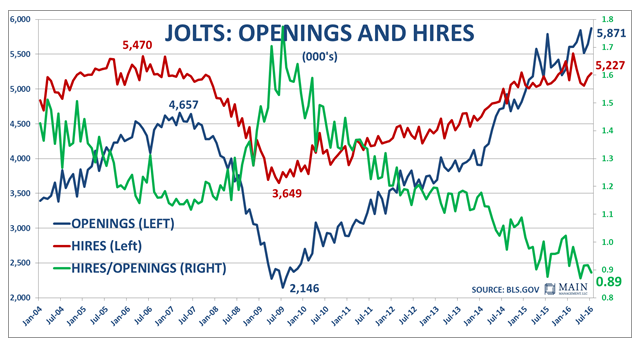What the JOLTS and other related data may indicate about the direction of the economy
By Hafeez Esmail, Main Management Chief Compliance Officer
When most people hear the word “jolt” it tends to conjure up thoughts related to a surge of electricity. However with respect to economic data it refers to something quite different. The Job Openings and Labor Turnover Survey (JOLTS) may provide some interesting insights into the employment picture. The July JOLTS data showed that the number of people quitting their jobs (Quits) moved higher while layoffs declined.
When the number of people leaving their jobs (Quits) increases it’s usually because people are confident in their ability to get another job. That tends to suggest a more robust employment picture. There are additional reasons for those leaving their jobs to feel emboldened. As the chart below indicates, the number of job openings increased sharply to 5.87 million in July, and the number of people hired also moved higher to 5.23 million. That said, the rate of hiring did grow at a slower pace than the number of openings.
The ratio of hires to job openings moved lower to 0.89 underscoring that there are more open jobs than positions being filled. One of the reasons that openings do not match the pace of hiring may be because there is a mismatch between the skill set of workers and the type of job openings. As an example, if one person leaves his job as an auto technician, he probably wouldn’t have the skills needed for a job opening as a computer engineer.
The National Federation of Independent Business (NFIB) August 2016 Report of Small Business Economic Trends indicated that 30% of small business owners “said they had job openings that they couldn’t fill”. In addition, 15% said that “finding qualified workers was their biggest problem”. Both observations point to the skill set mismatch as a possible root cause.
SEE MORE: Vanishing Sovereign Bond Yields Around the Developed World


